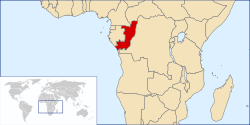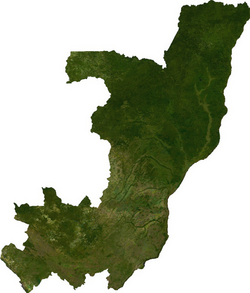Geography of the Republic of the Congo


1°00′S 15°00′E / 1.000°S 15.000°E The Republic of the Congo is located in the western part of central Africa, on the Equator. Congo has several important ports. The Republic of the Congo covers an area of 342,000 km², of which 341,500 km² is land while 500 km² is water. Congo claims 200 nautical miles (370 km) of territorial sea.
The capital of the Republic of the Congo is Brazzaville, located on the Congo River immediately across from Kinshasa, capital of the Democratic Republic of the Congo. With a metropolitan population of approximately 1.5 million, Brazzaville is by far the largest city in the Republic, having almost twice the population of Pointe-Noire (663,400 as of the 2005 census), the country's second largest city. About 70% of the population lives in Brazzaville, Pointe-Noire, or along the railroad between them.
Area and boundaries
- Area
-
- Total: 342,000 km²
- country rank in the world: 64th
- Land: 341,500 km²
- Water: 500 km²
- Total: 342,000 km²
- Area comparative
-
- Australia comparative: approximately 1+1/2 times the size of Victoria
- Canada comparative: approximately 1/7 smaller than Newfoundland and Labrador
- United Kingdom comparative: approximately 2/5 larger than the United Kingdom
- United States comparative: approximately twice the size of Florida
- EU comparative: slightly smaller than Germany
- Land boundaries
-
- Total: 5,008 kilometres or 3,112 miles
- Border countries: Cabinda (Angola) (231 kilometres or 144 miles), the Democratic Republic of the Congo (1,229 kilometres or 764 miles), Central African Republic (487 kilometres or 303 miles), Cameroon (494 kilometres or 307 miles), Gabon (2,567 kilometres or 1,595 miles).
- Coastline
- 169 km on Atlantic Ocean
Environment
Climate
Congo is a tropical nation, which means it has a tropical climate. The wet season lasts from March to June and the dry season for the rest of the year. Temperature and humidity are high as in all tropical nations. The rivers of the country are flooded seasonally.
| Climate data for Brazzaville (Maya-Maya Airport) 1961–1990, extremes 1932–present | |||||||||||||
|---|---|---|---|---|---|---|---|---|---|---|---|---|---|
| Month | Jan | Feb | Mar | Apr | May | Jun | Jul | Aug | Sep | Oct | Nov | Dec | Year |
| Record high °C (°F) | 37.5 (99.5) |
36.3 (97.3) |
37.5 (99.5) |
36.8 (98.2) |
37.3 (99.1) |
34.3 (93.7) |
33.8 (92.8) |
40.2 (104.4) |
39.5 (103.1) |
38.9 (102.0) |
35.8 (96.4) |
40.2 (104.4) |
40.2 (104.4) |
| Mean daily maximum °C (°F) | 30.5 (86.9) |
31.3 (88.3) |
31.7 (89.1) |
31.8 (89.2) |
30.9 (87.6) |
28.4 (83.1) |
27.0 (80.6) |
28.5 (83.3) |
30.4 (86.7) |
30.8 (87.4) |
30.4 (86.7) |
30.2 (86.4) |
30.2 (86.4) |
| Daily mean °C (°F) | 26.0 (78.8) |
26.4 (79.5) |
26.7 (80.1) |
26.8 (80.2) |
26.2 (79.2) |
23.8 (74.8) |
22.4 (72.3) |
23.6 (74.5) |
25.5 (77.9) |
26.1 (79.0) |
25.9 (78.6) |
25.8 (78.4) |
25.4 (77.7) |
| Mean daily minimum °C (°F) | 21.4 (70.5) |
21.5 (70.7) |
21.7 (71.1) |
21.9 (71.4) |
21.6 (70.9) |
19.3 (66.7) |
17.8 (64.0) |
18.8 (65.8) |
20.6 (69.1) |
21.4 (70.5) |
21.4 (70.5) |
21.5 (70.7) |
20.7 (69.3) |
| Record low °C (°F) | 17.0 (62.6) |
14.5 (58.1) |
17.7 (63.9) |
18.6 (65.5) |
17.0 (62.6) |
12.7 (54.9) |
10.5 (50.9) |
10.3 (50.5) |
15.2 (59.4) |
13.7 (56.7) |
18.2 (64.8) |
17.7 (63.9) |
10.3 (50.5) |
| Average precipitation mm (inches) | 160 (6.3) |
137 (5.4) |
167 (6.6) |
191 (7.5) |
118 (4.6) |
8 (0.3) |
3 (0.1) |
4 (0.2) |
34 (1.3) |
139 (5.5) |
261 (10.3) |
172 (6.8) |
1,394 (54.9) |
| Average precipitation days (≥ 1.0 mm) | 10 | 8 | 11 | 12 | 8 | 1 | 0 | 0 | 4 | 9 | 14 | 12 | 89 |
| Average relative humidity (%) | 81 | 80 | 79 | 81 | 81 | 79 | 77 | 73 | 71 | 76 | 81 | 82 | 78 |
| Mean monthly sunshine hours | 171 | 167 | 192 | 181 | 177 | 141 | 127 | 133 | 145 | 152 | 157 | 154 | 1,897 |
| Source 1: Deutscher Wetterdienst (humidity, 1951–1990)[1][2][a] | |||||||||||||
| Source 2: Meteo Climat (record highs and lows)[3] | |||||||||||||
| Climate data for Pointe-Noire 1982-2012 | |||||||||||||
|---|---|---|---|---|---|---|---|---|---|---|---|---|---|
| Month | Jan | Feb | Mar | Apr | May | Jun | Jul | Aug | Sep | Oct | Nov | Dec | Year |
| Mean daily maximum °C (°F) | 30.6 (87.1) |
30.9 (87.6) |
31.5 (88.7) |
31.3 (88.3) |
29.7 (85.5) |
27.5 (81.5) |
25.8 (78.4) |
25.7 (78.3) |
26.8 (80.2) |
28.6 (83.5) |
29.3 (84.7) |
29.7 (85.5) |
29.0 (84.1) |
| Daily mean °C (°F) | 27.5 (81.5) |
27.6 (81.7) |
27.9 (82.2) |
27.7 (81.9) |
26.8 (80.2) |
24.4 (75.9) |
22.9 (73.2) |
23.1 (73.6) |
24.3 (75.7) |
26.2 (79.2) |
26.8 (80.2) |
26.9 (80.4) |
26.0 (78.8) |
| Mean daily minimum °C (°F) | 24.3 (75.7) |
24.3 (75.7) |
24.4 (75.9) |
24.2 (75.6) |
23.8 (74.8) |
21.4 (70.5) |
20.0 (68.0) |
20.4 (68.7) |
21.8 (71.2) |
23.8 (74.8) |
24.1 (75.4) |
24.0 (75.2) |
23.0 (73.5) |
| Average precipitation mm (inches) | 151.8 (5.98) |
183.6 (7.23) |
154.0 (6.06) |
92.7 (3.65) |
45.7 (1.80) |
2.2 (0.09) |
1.7 (0.07) |
5.7 (0.22) |
17.1 (0.67) |
96.6 (3.80) |
126.1 (4.96) |
153.9 (6.06) |
1,031.1 (40.59) |
| Source: Normales et records pour la période 2000-2016 à Pointe-Noire[4] | |||||||||||||
| Climate data for Ouésso | |||||||||||||
|---|---|---|---|---|---|---|---|---|---|---|---|---|---|
| Month | Jan | Feb | Mar | Apr | May | Jun | Jul | Aug | Sep | Oct | Nov | Dec | Year |
| Mean daily maximum °C (°F) | 31 (88) |
32 (89) |
32 (90) |
33 (91) |
31 (88) |
30 (86) |
29 (85) |
29 (85) |
30 (86) |
31 (87) |
31 (87) |
30 (86) |
31 (87) |
| Mean daily minimum °C (°F) | 21 (69) |
21 (69) |
22 (71) |
22 (71) |
22 (71) |
21 (70) |
21 (69) |
21 (69) |
21 (69) |
21 (69) |
21 (69) |
20 (68) |
21 (70) |
| Average rainfall mm (inches) | 56 (2.2) |
79 (3.1) |
150 (5.9) |
130 (5) |
150 (6) |
120 (4.6) |
79 (3.1) |
150 (6.1) |
220 (8.7) |
230 (8.9) |
150 (6) |
84 (3.3) |
1,598 (62.9) |
| Source: Weatherbase [5] | |||||||||||||
Ecology
The terrain is a variation of coastal plains, mountainous regions, plateaus and fertile valleys. About 70 percent of the country's area is covered by rain forest. The highest point, at 1,020 m, is Mont Nabeba in the Mayumbe mountains. The major rivers are the Congo River at the border with the Democratic Republic of the Congo, and the Kouilou-Niari River.
A 2014 expedition leaving from Itanga village discovered a peat bog "as big as England" which stretches into neighboring Democratic Republic of Congo.[6]
UNESCO has declared two world biosphere reserves in the country: Odzala in 1977 and Dimonika in 1988.[7]
Natural resources
Natural resources include petroleum, timber, potash, lead, zinc, uranium, copper, phosphates, gold, magnesium, natural gas, and hydropower.
As of a 2012 estimate, 1.55% of the land is arable, while only 0.20% contains permanent crops. Approximately 20 km² is irrigated (2003 estimation).
Environmental issues
Environmental issues include the high level of air pollution from vehicle emissions, water pollution from the dumping of raw sewage, tap water not being potable, and deforestation.
Congo is party to the international agreements on Biodiversity, Climate Change, Desertification, Endangered Species, Ozone Layer Protection, Tropical Timber 83, Tropical Timber 94, Wetlands. It has signed but not ratified the Law of the Sea and so on.
Extreme points
This is a list of the extreme points of the Republic of Congo, i.e. the points that are farther north, south, east, or west than any other location.
- Northernmost point — unnamed location on the border with Central African Republic immediately south-west of the CAR town of Madoukou, Likouala department
- Easternmost point — Motenge-Bom, Likouala department
- Southernmost point — unnamed headland near the point at which the Congo-Cabinda border enters the Atlantic Ocean, Kouilou department
- Westernmost point — the point at which the border with Gabon enters the Atlantic Ocean, Kouilou department
Notes
- ^ Station ID for Brazzaville/ Maya–Maya is 64450 Use this station ID to locate the sunshine duration — note link is 2017 text file download @ archive.org
References
- ^ "Klimatafel von Brazzaville (Flugh.) / Kongo" (PDF). Baseline climate means (1961–1990) from stations all over the world (in German). Deutscher Wetterdienst. Archived (PDF) from the original on 11 February 2020. Retrieved 24 October 2016.
- ^ "Station 64450 Brazzaville/ Maya–Maya". Global station data 1961–1990—Sunshine Duration. Deutscher Wetterdienst. Archived from the original on 2017-10-17. Retrieved 24 October 2016.
- ^ "Station Brazzaville" (in French). Meteo Climat. Archived from the original on 6 March 2018. Retrieved 24 October 2016.
- ^ "Normales et records pour la période 2000-2016 à Pointe-Noire". Infoclimat. Retrieved 2014-01-13.
- ^ "Weatherbase: Historical Weather for Ouesso, Republic of Congo". Weatherbase. 2011. Retrieved on November 24, 2011.
- ^ Smith, David (2014-05-27). "Peat bog as big as England found in Congo". The Guardian: World news. Retrieved 2014-05-31.
- ^ "Congo". UNESCO. Retrieved 22 June 2016.
- "CIA - The World Factbook -- Congo, Republic of the". The World Factbook. Central Intelligence Agency. 2008. Retrieved 2008-02-04.



